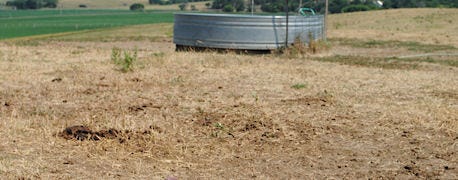November 18, 2012

By Jim Isleib, Michigan State University Extension
When hay fields or pastures need improvement, farmers have options ranging from low to high cost and risk. Newer producers sometimes jump to the conclusion that the best approach is to work up the field and re-seed. This is sometimes a good choice, but acceptable results can often be gained by other, less expensive and less risky actions.

Cost Of Renovating Hay Or Pasture Fields In Northern Michigan
Soil test and fertilize
The $12 cost of a standard Michigan State University soil test isn't much when divided among the acres tested. Twenty acres is the maximum area recommended by Michigan State University Extension for a single soil test, resulting in a cost of $0.60 per acre. Taking care to collect good, representative soil samples is important. The MSU Soil and Plant Nutrient Laboratory will generate a report of soil fertility components including pH, lime index, phosphorus, potassium, calcium and magnesium levels, and cation exchange capacity. Crop nutrient recommendations will also be included. This information can reveal bottleneck nutrient deficiencies in particular fields.
Naturally, farmers don't have to follow MSU advice or advice from any other lab. However, recommendations can be used to decide which fields are in most critical need of nutrients. Pasture and hay field performance can often be dramatically improved by feeding the crop what it desperately needs.
Improved grazing practices
If the farm includes a livestock enterprise, changes in pasture management can make significant improvements in stand density, species composition, manure distribution and forage yield. Improved rotational grazing practices will provide an adequate rest period for grass and legumes between grazing events, encouraging healthy and competitive forage plants. Costs associated with improved grazing practices include fencing and watering systems.
Frost seeding
Frost seeding red clover or birdsfoot trefoil can be an effective way to improve the legume component of grassy pastures. Timing and ground conditions are important factors. Frost seedings do not work well on sandy soils. Heavy grazing the fall before a spring frost seeding will allow for better seed/soil contact during the spring frost heaving period.
Using a no-till seeder to introduce legumes and grasses into live sod is another method with a better likelihood of seed/soil contact, especially in sandy soils. Frost seeding is by no means a sure thing. For more information on frost seeding, check out the MSU Extension article, March is frost seeding month in Michigan.
Work up and re-seed
On high-producing hay fields capable of supporting good alfalfa stands, this is a common rotation component. For less fertile and productive sites, it should be approached with a lot of critical thinking. MSUExtension educators are occasionally called upon to provide ballpark cost estimates for renovating poor hay fields. A recent estimate developed for an eastern Upper Peninsula mixed grass/legume seeding is as follows.
Field work (cost per acre):
Soil test = $0.60
Spray Roundup = $5.46
Moldboard plow = $17.85
Disk (two times) = $25.72 (12.86 x 2)
Spread dry fertilizer = $6.21
Plant = $12
Clip weeds = $12.57
Subtotal = $80.41
Input costs per acre:
Glyphosate herbicide = $12
2 tons lime (spread) = $82.86 (this is total cost for an estimated three-year period)
Seed = $45.00
Fertilizer = $182.00 (150 lbs 18-46-0 + 300 lbs 0-0-60)
Subtotal = $326.86
Total estimated cost: $80.41 + $326.86 = $407.27 per acre
This simplified budget uses custom field work rates, including labor and equipment ownership costs, fromMSU Extension educator Dennis Stein's2012 Custom Machine and Work Rate Estimates. Land costs are not included. If this investment in renovation had been spent in the spring of 2012, results would probably have been disappointing due to extreme drought conditions. The risks associated with complete renovation are high. If this field has a fair stand of grass in place, fertilization and frost seeding may be an acceptable, and cheaper, alternative.
You May Also Like




